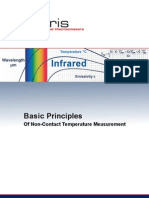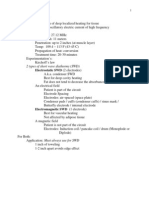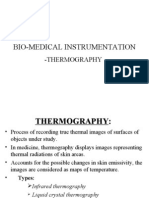Principle of Thermal Imaging
Principle of Thermal Imaging
Uploaded by
Dodik NugrohoCopyright:
Available Formats
Principle of Thermal Imaging
Principle of Thermal Imaging
Uploaded by
Dodik NugrohoOriginal Description:
Original Title
Copyright
Available Formats
Share this document
Did you find this document useful?
Is this content inappropriate?
Copyright:
Available Formats
Principle of Thermal Imaging
Principle of Thermal Imaging
Uploaded by
Dodik NugrohoCopyright:
Available Formats
Principle of Thermal Imaging
(NEC San-ei Instruments, Ltd.)
A
ll materials, which are above 0 degrees Kelvin (-273 degrees C), emit infrared energy. The infrared
energy emitted from the measured object is converted into an electrical signal by the imaging
sensor (microbolometer) in the camera and displayed on a monitor as a color or monochrome
thermal image. The basic principle is explained as follows:
Infrared Radiation
T
he infrared ray is a form of electromagnetic radiation the same as radio waves, microwaves,
ultraviolet rays, visible light, X-rays, and gamma rays. All these forms, which collectively make up the
electromagnetic spectrum, are similar in that they emit energy in the form of electromagnetic waves
traveling at the speed of light. The major difference between each ‘band’ in the spectrum is in their
wavelength, which correlates to the amount of energy the waves carry. For example, while gamma rays
have wavelengths millions of times smaller than those of visible light, radio waves have wavelengths that
are billions of times longer than those of visible light.
The wavelength of the infrared radiation ‘band’ is 0.78 to 1000μm (micrometers). This is longer than the
wavelength of visible light yet shorter that radio waves. The wavelengths of infrared radiation are
classified from the near infrared to the far infrared.
Emissivity
I
nfrared radiation is energy radiated by the motion of atoms and molecules on the surface of object,
where the temperature of the object is more than absolute zero. The intensity of the emittance is a
function of the temperature of the material. In other words, the higher the temperature, the greater the
intensity of infrared energy that is emitted. As well as emitting infrared energy, materials also reflect
infrared, absorb infrared and, in some cases, transmit infrared. When the temperature of the material
equals that of its surroundings, the amount of thermal radiation absorbed by the object equals the amount
emitted by the object.
The figure above shows the three modes by which the radiant energy striking an object may be dissipated.
These modes of dissipation are:
a = absorption
t = transmission
r = reflection
The fractions of the total radiant energy, which are associated with each of the above modes of dissipation,
are referred to as the absorptivity (a) transmissivity (t) and the reflectivity (r) of the body. According to the
theory of conservation of energy, the extent to which materials reflect, absorb and transmit IR energy is
known as the emissivity of the material.
Blackbody Radiation
T
he emissivity of a body is defined formally by the equation below as the ratio of the radiant energy
emitted by the body to the radiation, which would be emitted by a blackbody at the same
temperature.
If all energy falling on an object were absorbed (no transmission or reflection), the absorptivity would equal
to 1. At a steady temperature, all the energy absorbed could e-radiated (emitted) so that the emissivity of
such a body would equal 1. Therefore blackbody,
absorptivity = emissivity = 1
Practical real life objects do not behave exactly as this ideal, but as described with transmissivity and
reflectivity,
absorptivity + transmissivity + reflectivity = 1
Energy radiated from the blackbody is described as follows [“Planck’s Law”.]
In order to obtain total radiant emittance of the blackbody, integrate the equation (1) through all
wavelengths (0 to infinity). The result is as follows and is called “Stefan-Bolzmann equation.”
The temperature of blackbody can be obtained directly from the radiant energy of the blackbody by this
equation. In order to find out the wavelength on the maximum spectral radiant emittance, differentiate
Planck’s law and take the value to 0
This equation is called “Wien’s displacement law”.
Where in (1) to (3),
In radiation of a normal object, as the emissivity is (<1) times of the blackbody, multiply above equation
by the emissivity. The following figures show the spectral radiant emittance of a blackbody.
The graphs show that wavelength and spectral radiant emittance vary with the temperature. They also
show that as the temperature rises, the peak of spectral radiant emittance is shifting to shorter
wavelengths. This phenomenon is observable in the visible light region as an object at a low temperature
appears red, and as the temperature increases, it changes to yellowish and then whitish color—thus
shifting to shorter & shorter wavelengths as the temperature increases.
(a) is shown by logarithmic scale and (b) is shown by linear scale.
Practical Measurement
T here are a number of methods for correcting emissivity in order to obtain the true temperature. The
correction procedure with each method will be explained next.
Method of comparison or direct measurement with emissivity equal
to approximately 1.0
a) Stabilize the temperature of the measured object or similar material.
b) Open a very small hole (hereafter called blackbody part) in the object which the thermal imager must
measure as to satisfy blackbody conditions.
c) Then set the emissivity correcting function of thermal imager so that the temperature of the blackbody
part and the measured surface will be the same. The obtained emissivity will be the emissivity of the
measured surface.
d) Thereafter when measuring the same type object, it is unnecessary to change the emissivity setting.
Method of direct measurement of emissivity
If a hole cannot be made as in method 1, then apply black high emissivity paint and carry out the same
procedures to obtain the emissivity. Since the black paint will not provide a perfect blackbody, first set the
emissivity of the black paint and then measure the temperature.
Indirect measurement
Measure a sample similar to the measured object, and place it in a condition able to be heated by a heater,
etc. Then measure the object and the sample alternately with the camera and when the indicated values
are identical, measure the sample with a contact-type thermometer. Adjust the emissivity of the thermal
imager to cause the temperature readout to match that of the contact measurement. The resulting
emissivitiy is that of the sample.
Measuring by Wedge effect
With this method, the emissivity of the measured surface itself is enhanced through use of the wedge or
semi-wedge effect. But one must be careful about the number of reflections and/or the measuring angle. A
small change in angle will reduce the emissivity enhancement.
You might also like
- Technical Specification: IEC TS 62446-3Document42 pagesTechnical Specification: IEC TS 62446-3David Garcia100% (2)
- Surveying and Geomatics - PK GARGDocument370 pagesSurveying and Geomatics - PK GARGG Kishore KumarNo ratings yet
- Basics InfraredDocument24 pagesBasics Infrareda.la_pica2161100% (1)
- Heat 4e Chap12 LectureDocument43 pagesHeat 4e Chap12 LectureSubho SamantaNo ratings yet
- 4.SOP Emergency Shut DownDocument5 pages4.SOP Emergency Shut DownDodik NugrohoNo ratings yet
- 500+ Electronics Project Ideas1Document51 pages500+ Electronics Project Ideas1tariq7671% (24)
- Thermography PDFDocument12 pagesThermography PDFAnthonio MJNo ratings yet
- Thermography Fundamentals and First Principals of Natural Sciences and Engineering SciencesDocument12 pagesThermography Fundamentals and First Principals of Natural Sciences and Engineering SciencesNabil AbdullahNo ratings yet
- Measurement Intensity of Black Body Radiation As Temperature Function (Stefan-Boltzmann's Law)Document5 pagesMeasurement Intensity of Black Body Radiation As Temperature Function (Stefan-Boltzmann's Law)Ikhsan Mandala PutraNo ratings yet
- Basic Principles: of Non-Contact Temperature MeasurementDocument32 pagesBasic Principles: of Non-Contact Temperature Measurementanon_731358044No ratings yet
- Lecture Thermography PresentationDocument30 pagesLecture Thermography PresentationDhruv SahniNo ratings yet
- Transport Lab Report Experiment 3Document18 pagesTransport Lab Report Experiment 3nurul nabilah bt khairul anuar100% (2)
- Basic Principles: of Non-Contact Temperature MeasurementDocument32 pagesBasic Principles: of Non-Contact Temperature Measurementdomingosccp5456No ratings yet
- Chem 242 DR - Salwa M. Al-Rashed: Associate Professor of Physical ChemistryDocument34 pagesChem 242 DR - Salwa M. Al-Rashed: Associate Professor of Physical ChemistryMark Carmelo A AzorNo ratings yet
- More Precision.: Basics of Non Contact Temperature MeasurementDocument20 pagesMore Precision.: Basics of Non Contact Temperature MeasurementAnonymous jmCvEw100% (1)
- Thermal Radiation ExperimentDocument4 pagesThermal Radiation ExperimentloginfornagpalNo ratings yet
- HT Assignmet 4 MM19M11Document34 pagesHT Assignmet 4 MM19M11Chetan ChaudhariNo ratings yet
- Module 3 - Elements of Quantum Mechanics NotesDocument40 pagesModule 3 - Elements of Quantum Mechanics NotesMahek KhushalaniNo ratings yet
- SAC 623 Remote Sensing and GIS Techniques For Soil and Crop Studies (2+1) Lecture No. 1 PrinciplesDocument100 pagesSAC 623 Remote Sensing and GIS Techniques For Soil and Crop Studies (2+1) Lecture No. 1 PrinciplesTejasri PinnapareddyNo ratings yet
- Satellite Remote SensingDocument52 pagesSatellite Remote SensingAnonymous yjF4yygpPbNo ratings yet
- Infrared Thermographic Systems: A Review of IR Imagers and Their UseDocument54 pagesInfrared Thermographic Systems: A Review of IR Imagers and Their UsedansileshiNo ratings yet
- Basics Non Contact Temperature Measurement Infrared Thermometers MicroEpsilonDocument24 pagesBasics Non Contact Temperature Measurement Infrared Thermometers MicroEpsilonJatra Bayu BwtddNo ratings yet
- Remote Sensing SciOlyDocument8 pagesRemote Sensing SciOlyDevakh Rashie (Dev)No ratings yet
- Thermal Remote SensingDocument16 pagesThermal Remote SensingAkhilesh SinghNo ratings yet
- LAB 3 Radiation Heat TrasferDocument16 pagesLAB 3 Radiation Heat TrasferMastura Ahmad Termizi89% (19)
- Fundamentals of Thermal RadiationDocument42 pagesFundamentals of Thermal RadiationEMMANUEL DELOS SANTOSNo ratings yet
- Radiation Heat TransferDocument14 pagesRadiation Heat Transferniyasking0123No ratings yet
- Lecture Note Module 10Document66 pagesLecture Note Module 10GokhanNo ratings yet
- Chapter 5 Version WhiteDocument41 pagesChapter 5 Version WhiteMUHAMMAD IZZUDDIN BIN NASIR STUDENTNo ratings yet
- Plancks Constant Version 2016-1Document10 pagesPlancks Constant Version 2016-1MR XNo ratings yet
- Quantum Physics: Black Body RadiationDocument7 pagesQuantum Physics: Black Body Radiationsmcoolguy68No ratings yet
- Illumination Notes NM PDFDocument17 pagesIllumination Notes NM PDFhimNo ratings yet
- Introduction To Thermal Imaging: Joseph E. Osowski, PEDocument18 pagesIntroduction To Thermal Imaging: Joseph E. Osowski, PEashokmmmNo ratings yet
- Chapter 12 Fundamentals of Thermal RadiationDocument45 pagesChapter 12 Fundamentals of Thermal RadiationKAYAIRA TATENo ratings yet
- Act 5 RadiationExperiments Grp1Document10 pagesAct 5 RadiationExperiments Grp1Junn Edgar LibotNo ratings yet
- White Paper Measurement of MetalDocument4 pagesWhite Paper Measurement of MetalFerdinan Tulus Yones TobingNo ratings yet
- It0409 16 PDFDocument4 pagesIt0409 16 PDFAnthonio MJNo ratings yet
- Lec32 Phy101Document16 pagesLec32 Phy101amnasaab0312No ratings yet
- AP NotesDocument124 pagesAP Notessuzanirfan2004No ratings yet
- Fundamentals of Thermal RadiationDocument14 pagesFundamentals of Thermal Radiationbommareddy akashreddyNo ratings yet
- Electrical Engineering - Remote SensingDocument43 pagesElectrical Engineering - Remote SensingAnaStairsNo ratings yet
- Lecture Remote Sensing 008 ThermalDocument29 pagesLecture Remote Sensing 008 Thermalcurious aimNo ratings yet
- TRE Radiation FormsDocument11 pagesTRE Radiation FormsDamisha DamishaNo ratings yet
- Atomic structure and chemical bonding (lecture not_220916_112919 (1)Document87 pagesAtomic structure and chemical bonding (lecture not_220916_112919 (1)kairuduxNo ratings yet
- Thermo L13Document56 pagesThermo L13Pronto P ChirinkaNo ratings yet
- Unit 5 - Heat and Mass TransferDocument19 pagesUnit 5 - Heat and Mass TransferSALMAN FARIS CPNo ratings yet
- Dipartimento Di Fisica Universita' Della Calabria Corso Di Laurea Magistrale in Fisica A.A. 2016/2017Document12 pagesDipartimento Di Fisica Universita' Della Calabria Corso Di Laurea Magistrale in Fisica A.A. 2016/2017Diego Blady HaroNo ratings yet
- Resistance Thermometers and Radiation PyrometersDocument12 pagesResistance Thermometers and Radiation PyrometersUv sai likithNo ratings yet
- QM Complete Module AKSrivastavaDocument61 pagesQM Complete Module AKSrivastavathedivanshugroverNo ratings yet
- Radiation PDF by SirDocument12 pagesRadiation PDF by Sirgogoidebojit562No ratings yet
- Chapter1blackbodyradiation 131023012246 Phpapp02 PDFDocument29 pagesChapter1blackbodyradiation 131023012246 Phpapp02 PDFShakir KhattakNo ratings yet
- Infrared Pyrometer HandbookDocument19 pagesInfrared Pyrometer Handbookjoyous leeNo ratings yet
- Chapter - 5Document21 pagesChapter - 5BISRAT YIHUNNo ratings yet
- B N T NG H P Semilar 02Document22 pagesB N T NG H P Semilar 02Huy NguyễnNo ratings yet
- Infrared Thermography: Radiation Is The Transfer of Heat Through Electromagnetic WavesDocument9 pagesInfrared Thermography: Radiation Is The Transfer of Heat Through Electromagnetic WavesMahendraNath Reddy ENo ratings yet
- Heat and Mass Transfer Lecture Notes AssignmentDocument7 pagesHeat and Mass Transfer Lecture Notes Assignmenttakundapaswane304No ratings yet
- Radiation Heat Transfer PDFDocument6 pagesRadiation Heat Transfer PDFعبدالمؤمن خالد محمودNo ratings yet
- Radiation Heat Transfer PDFDocument6 pagesRadiation Heat Transfer PDFعبدالمؤمن خالد محمودNo ratings yet
- Planck'smanual v1Document12 pagesPlanck'smanual v1spyzer.x.001No ratings yet
- Intensity of Electromagnetic Waves as a Function of Frequency, Source Distance and Aperture AngleFrom EverandIntensity of Electromagnetic Waves as a Function of Frequency, Source Distance and Aperture AngleNo ratings yet
- Charge Radiation Derived from the Universal Electrodynamic Force - Proof of the Cherenkov EffectFrom EverandCharge Radiation Derived from the Universal Electrodynamic Force - Proof of the Cherenkov EffectNo ratings yet
- Ophthalmic Dispensing Revision Guide: First Year Part OneFrom EverandOphthalmic Dispensing Revision Guide: First Year Part OneRating: 4 out of 5 stars4/5 (3)
- Electrostatic PrecipitatorDocument1 pageElectrostatic PrecipitatorDodik NugrohoNo ratings yet
- 1 Concept of Precipitation 23 enDocument23 pages1 Concept of Precipitation 23 enDodik NugrohoNo ratings yet
- 3 Phase DistributionDocument3 pages3 Phase DistributionDodik NugrohoNo ratings yet
- 11.SOP Condensate PumpDocument7 pages11.SOP Condensate PumpDodik Nugroho100% (1)
- 9.SOP Barring Gear or Turning GearDocument5 pages9.SOP Barring Gear or Turning GearDodik Nugroho100% (1)
- 1.SOP Turbine Start UpDocument7 pages1.SOP Turbine Start UpDodik NugrohoNo ratings yet
- GGAj 05 - EPCS V - Ȧ +Document86 pagesGGAj 05 - EPCS V - Ȧ +Dodik NugrohoNo ratings yet
- Electronic Stick For Visual Disabled PeopleDocument58 pagesElectronic Stick For Visual Disabled PeopleAnkurNo ratings yet
- IoT Based Smart Parking SystemDocument12 pagesIoT Based Smart Parking SystemShubham SagarNo ratings yet
- Past Paper 2Document20 pagesPast Paper 2ishaya lyndemNo ratings yet
- Optics UnitDocument136 pagesOptics UnitReshmaNo ratings yet
- Celulosa MicrocristalinaDocument5 pagesCelulosa MicrocristalinaPaola LopezNo ratings yet
- FLIR B335 DatasheetDocument2 pagesFLIR B335 Datasheetstelios_yuhas4576No ratings yet
- IR Inspection Program For Fired Heater Mechanical Integrity: New Product!Document1 pageIR Inspection Program For Fired Heater Mechanical Integrity: New Product!bazil17No ratings yet
- E65 DatasheetDocument2 pagesE65 DatasheetFajar FaisalNo ratings yet
- Docu - Sumo - Group ProjectDocument11 pagesDocu - Sumo - Group ProjectInah PayosNo ratings yet
- Shortwave Diathermy: 2 Types of Short Wave Diathermy (SWD)Document19 pagesShortwave Diathermy: 2 Types of Short Wave Diathermy (SWD)bjpalmer100% (2)
- Guidelines For Making and Scoring of Free-Response QuestionsDocument53 pagesGuidelines For Making and Scoring of Free-Response Questionssakshi.sNo ratings yet
- BMIDocument11 pagesBMIapi-37578380% (1)
- MCQs On Class 12 Physics Chapter 8 Electromagnetic WavesDocument8 pagesMCQs On Class 12 Physics Chapter 8 Electromagnetic WavesAkshith ReddyNo ratings yet
- 3d Scanning With The KinectDocument24 pages3d Scanning With The KinectluomclcNo ratings yet
- 1159-2019 - IEEE Recommended Practice For Monitoring Electric Power QualityDocument15 pages1159-2019 - IEEE Recommended Practice For Monitoring Electric Power QualityEko SutjiptoNo ratings yet
- Lfa 457 Thermal TesterDocument12 pagesLfa 457 Thermal TesterlbnxxxxNo ratings yet
- 600542-E AgriSpec User ManualDocument72 pages600542-E AgriSpec User Manual정관용No ratings yet
- L3 WS CatDocument19 pagesL3 WS CatRazza Willi100% (1)
- Manual CU 1106 Rev1Document17 pagesManual CU 1106 Rev1Jose Maria PerezNo ratings yet
- Atp 71Document136 pagesAtp 71João FródrsonNo ratings yet
- Factsheet Ric290 2018-08 en WebDocument2 pagesFactsheet Ric290 2018-08 en WebAndres AlvarezNo ratings yet
- FTIR2017full PDFDocument74 pagesFTIR2017full PDFRurintana Nalendra WarnaNo ratings yet
- Infrarrojos y UltrasónicosDocument81 pagesInfrarrojos y UltrasónicosgdiliogNo ratings yet
- Band Combinations and Their UtilitiesDocument17 pagesBand Combinations and Their UtilitiesHamza AbbasiNo ratings yet
- Fire Alarm SystemDocument50 pagesFire Alarm SystemMayada SaadNo ratings yet
- Class 5 - Ch. 11-13 NotesDocument8 pagesClass 5 - Ch. 11-13 Notesmark chenNo ratings yet
- 15.quality Control System For Paper Machines (Read-Only) (Compatibility Mode)Document19 pages15.quality Control System For Paper Machines (Read-Only) (Compatibility Mode)Sudhakara RaoNo ratings yet

































































































